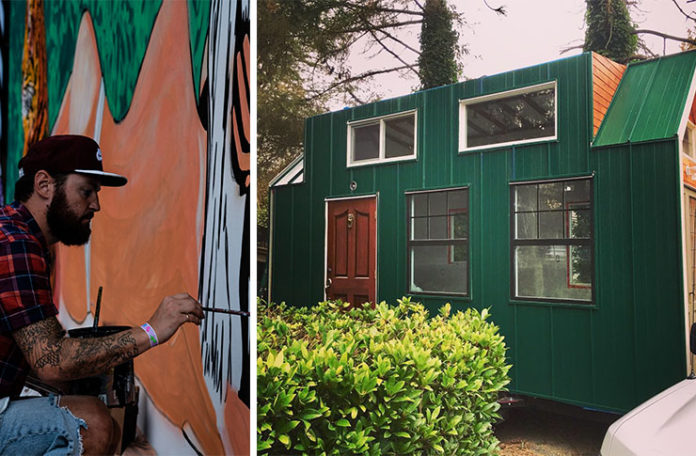
Is Tiny House Living For You?
“I believe everyone should own a home” Nick Gregson
We’ve all heard that living in nature is good for our health but also for our wallet? As cities expand in density and air pollution rises, many are looking to alternative modes of living that may be more cost effective, closer to nature and less impactful on the environment.

In cities, we not only battle pollution and traffic, we also battle the cost of living. As urban centres become too expensive, many relocate to smaller Provinces seeking out alternative ways of existing.
Following the big financial crisis of 2008, the tiny house movement gained popularity for offering a simpler, more sustainable alternative to large urban living. With a tiny house you were suddenly mobile, debt free and closer to nature.

Across Canada and the United States tiny house living is still an anomaly and not every Province or State allows it, but in British Columbia, tiny house communities exist, are legal and a viable option.
Tiny House Builder Nick Gregson: “A thoughtful tiny home can reduce outside energy needs; with smart design, energy saving construction techniques and home generated power. It’s obvious to me that we have forgotten the basics of good energy management and I knew there must be a better way to design and build homes that capture the sun’s heat to work in harmony with nature. The housing crisis has opened a market for new ideas about housing. Nature has been providing earth with abundance for millennia. Humanity will need to use what nature offers because fossil fuels will be a tiny blimp in human history and traditional “alternative” energy like bio gas can provide a gas similar to propane. ”
Each year, farmers in the U.S. produce 200 million tons of straw rice hulls, 10 times the amount needed to insulate every new home that could be built by utilizing agricultural products; while heating water with solar is the most cost effective technology to install into a home after a clothesline.

What’s more, water can store twice as much heat energy as concrete or rocks and circulating hot water with Pex piping in concrete floors has the best reputation for cost savings.
80 percent of homes built in North America are wood frame. An average 2×6 framed house uses approximately 40 full grown trees, the equivalent of 2 acres. These trees take a minimum of 40 years to grow back. The embedded cost of producing cement is a significant percentage of the worlds greenhouse gases. With such enormous waste of precious resources going into home building, minimally produced or salvaged materials score best.
The power necessary to operate buildings and for the construction of building materials is the largest energy consuming sector in the U.S. Smart design can lower the energy use in a house by about 50 percent. The future looks bright for builders if home owners and architects work together to carve a path forward.

Nick Continues, “The life cycle of materials is also a consideration as well as choosing local materials to reduce transportation costs. You want to use materials that decompose back into the earth harmlessly so that you leave the minimum possible footprint while clean water is becoming more and more precious, so using water multiple times a day through alternative methods can cut consumption by 40 percent. One can collect rain water and grey water can be used again for a garden or to flush the toilet. While compost toilets use biological systems to harmlessly process waste into plant food.”
According to Nick, it is now entirely practical to live comfortably off the grid by producing solar electricity for storage (using batteries) and propane gas for cooking. One can back up their system with a gas generator and wind and even hydroelectric turbines, which are sized for household needs.
“My suggestions is, don’t use more than you need and take responsibility for your energy needs”, Nick continues, “Harness the opportunities offered by the planet and enjoy the rewards. Being more aware of your energy needs is important, not just hitting a switch or knowing where it comes from, become aware of the processes of this huge global infrastructure.”
Small, sustainable living is not only good for our planet but also for our health. Regular exposure to Nature, living in proximity has been documented to Reduce stress, reduce depression, aid in better sleep, Reduce anxiety, Reduce aggression, Improve immune function, lower blood pressure and contribute to greater happiness, well-being, life satisfaction.
According to Environmental Health Perspective (ehp.niehs.nih.gov) Nature Contact and Human Health: A Research Agenda.
“Humans are increasingly disconnected from nature. Most people—over half globally, and approximately four in five Americans—live in urban areas, where nature contact is typically limited (United Nations 2015). Surveys reveal that Americans spend 90% of their time indoors: most of that time is spent in buildings, and a smaller portion in vehicles (Klepeis et al. 2001). Screen time has reached daily averages of 1 h 55 min for children younger than 8 y old (Rideout 2013) and 7 h 38 min for those between 8 and 18y old (Rideout et al. 2010).”
“In 2016, the average “total media consumption” was 10 h 39 min per day among adults and was rising (Nielsen 2016). Park visitation, hunting, fishing, camping, and children’s outdoor play have all declined substantially over recent decades (Clements 2004; Frost 2010; Pergams and Zaradic 2008).”
“In this context, recent years have seen a blossoming of scientific interest in the benefits of nature contact for human health and well-being. Several recent reviews have summarized and evaluated the growing evidence base (Bowler et al. 2010; Hartig et al. 2014; James et al. 2015; Lee and Maheswaran 2011; Martens and Bauer 2013; Russell et al. 2013; Seymour 2016). This literature reveals an extraordinarily broad range of benefits, albeit with varying levels of evidentiary support”
“According to the best available evidence, nature contact offers considerable promise in addressing a range of health challenges, including many, such as obesity, cardiovascular disease, depression, and anxiety, that are public health priorities. Nature contact offers promise both as prevention and as treatment across the life course. Potential advantages include low costs relative to conventional medical interventions, safety, practicality, not requiring dispensing by highly trained professionals, and multiple benefits. Few medications can boast these attributes.”
Based on the evidence, exposure to nature is plays a significant factor in how we feel; although living in the woods might not be for everyone, regular exposure to nature is possible with a little bit of forethought to how we conduct our daily lives. If living and building green is not in the cards for your right now, consider how you can contribute to resource conservation through how you manage water and electricity. At the end of the day, the benefits of nature are undeniable and we can all play a part it preserving it. So, what are you waiting for? Get outside!
Nick Gregson
Nick Gregson is a mural artist from East Vancouver. He volunteers with the city on the Arts and Culture Policy Council and does community outreach by teaching art techniques to youth. Nick currently has about 10 murals around Metro Vancouver and is working with the city to have more public art spaces available.
Nick also builds and designs tiny homes with his brother Ben Gregson. Nick received a scholarship to the BCIT construction program and has worked on and off in the trades since 1999.











